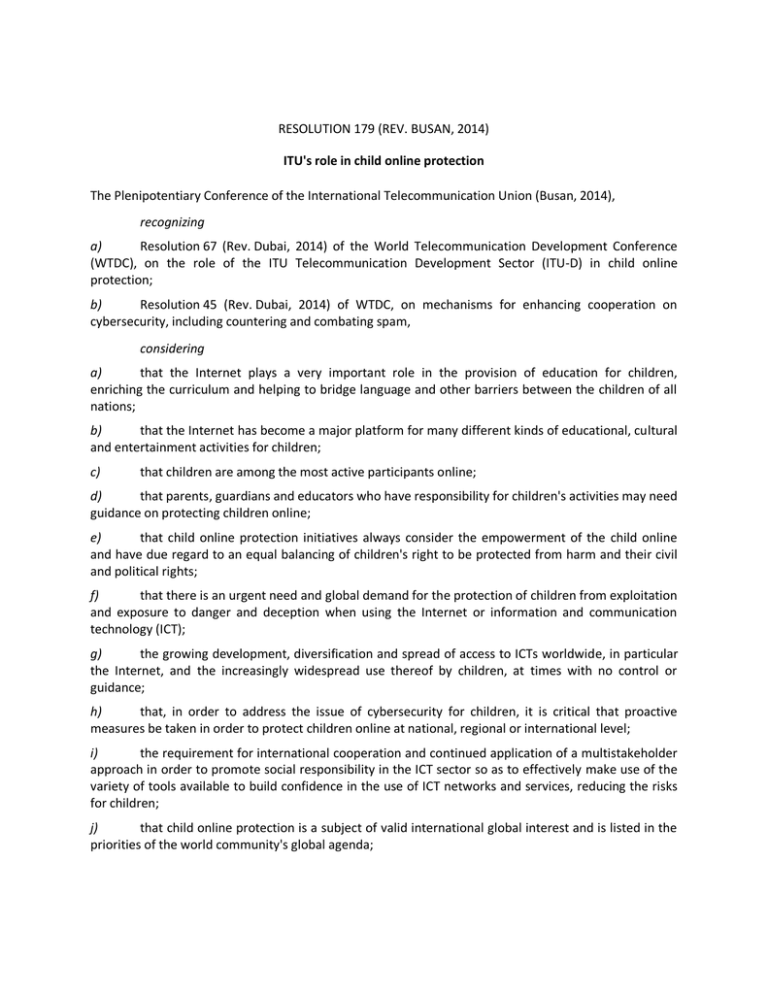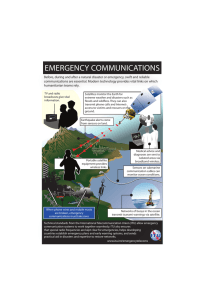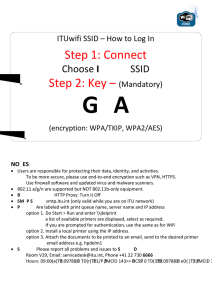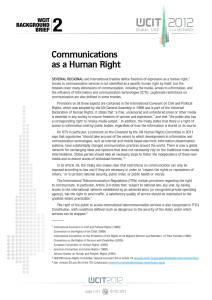RESOLUTION 179 (REV. BUSAN, 2014) ITU's role in child online protection
advertisement

RESOLUTION 179 (REV. BUSAN, 2014) ITU's role in child online protection The Plenipotentiary Conference of the International Telecommunication Union (Busan, 2014), recognizing a) Resolution 67 (Rev. Dubai, 2014) of the World Telecommunication Development Conference (WTDC), on the role of the ITU Telecommunication Development Sector (ITU-D) in child online protection; b) Resolution 45 (Rev. Dubai, 2014) of WTDC, on mechanisms for enhancing cooperation on cybersecurity, including countering and combating spam, considering a) that the Internet plays a very important role in the provision of education for children, enriching the curriculum and helping to bridge language and other barriers between the children of all nations; b) that the Internet has become a major platform for many different kinds of educational, cultural and entertainment activities for children; c) that children are among the most active participants online; d) that parents, guardians and educators who have responsibility for children's activities may need guidance on protecting children online; e) that child online protection initiatives always consider the empowerment of the child online and have due regard to an equal balancing of children's right to be protected from harm and their civil and political rights; f) that there is an urgent need and global demand for the protection of children from exploitation and exposure to danger and deception when using the Internet or information and communication technology (ICT); g) the growing development, diversification and spread of access to ICTs worldwide, in particular the Internet, and the increasingly widespread use thereof by children, at times with no control or guidance; h) that, in order to address the issue of cybersecurity for children, it is critical that proactive measures be taken in order to protect children online at national, regional or international level; i) the requirement for international cooperation and continued application of a multistakeholder approach in order to promote social responsibility in the ICT sector so as to effectively make use of the variety of tools available to build confidence in the use of ICT networks and services, reducing the risks for children; j) that child online protection is a subject of valid international global interest and is listed in the priorities of the world community's global agenda; k) that child online protection involves a national, regional and international collaborative network, in conjunction with other United Nations agencies and partners, for action to promote the online protection of children by providing guidance on safe online behaviour; recalling a) the United Nations Convention on the Rights of the Child (1989), the Declaration of the Rights of the Child adopted by the United Nations General Assembly on 20 November 1989 and recognized in the Universal Declaration of Human Rights, and all relevant United Nations resolutions regarding child protection and child online protection; b) that, within the framework of the Convention on the Rights of the Child, the States Parties undertook to protect the child from all forms of exploitation and sexual abuse, and for that purpose, in particular, to take all appropriate national, bilateral and multilateral measures to prevent a) the inducement or coercion of a child to engage in any unlawful sexual activity; b) the exploitative use of children in prostitution or other unlawful sexual practices; c) the exploitative use of children in pornographic performances and materials (Article 34); c) that, pursuant to Article 10 of the Optional Protocol to the Convention on the Rights of the Child (New York, 2000) on the sale of children, child prostitution and child pornography, the States Parties shall take all necessary steps to strengthen international cooperation by multilateral, regional and bilateral arrangements for the prevention, detection, investigation, prosecution and punishment of those responsible for acts involving the sale of children, child prostitution, child pornography and child sex tourism; and shall also promote international cooperation and coordination between their authorities, national and international non-governmental organizations and international organizations; d) UN Human Rights Council Resolution 20/8, adopted on 5 July 2012, which stresses that "the same rights that people have offline must also be protected online"; e) that the World Summit on the Information Society (WSIS), in the Tunis Commitment of 2005 (§ 24), recognized the role of ICTs in the protection of children and in enhancing the development of children, urging Member States to strengthen action to protect children from abuse and defend their rights in the context of ICTs, emphasizing that the best interests of the child are a primary consideration; accordingly, the Tunis Agenda for the Information Society (§ 90 q)) set forth the commitment to using ICTs as a tool to achieve the internationally agreed development goals and objectives, including the Millennium Development Goals, by, inter alia, incorporating regulatory, self-regulatory and other effective policies and frameworks to protect children and young people from abuse and exploitation through ICTs into national plans of action and e-strategies; f) that the Council Working Group on International Internet-related Public Policy Issues (CWG-Internet), whose role was established by the 2009 session of the Council, held an open consultation on protecting children and young people from abuse and exploitation in order to understand how, as one of the public policy issues, it will be discussed within the scope of CWG-Internet; g) Resolution 1306 adopted by the 2009 session of the Council, under which a child online protection working group was set up, with the participation of Member States and Sector Members, and its mandate was defined by the ITU members in close collaboration with the secretariat of the Union; h) that, during the 2012 WSIS Forum held in Geneva, a meeting was held with associates of the Child Online Protection (COP) initiative, at which it was agreed to work closely with the Family Online Safety Institute (FOSI) and the Internet Watch Foundation (IWF) to provide necessary assistance to Member States, recalling further a) that ITU is the moderator/facilitator for Action Line C5 (Building confidence and security in the use of ICTs); b) that the COP initiative was presented to the High-Level Segment of the Council in 2008, where it was endorsed by the Heads of State, ministers and heads of international organizations globally; c) that ITU, in collaboration with its COP members, has created four sets of guidelines for the protection of children in cyberspace, namely: Guidelines for children, Guidelines for parents, guardians and educators, Guidelines for industry and Guidelines for policy-makers; d) that, despite technical difficulties that have made it impossible to establish a single globally harmonized number, as provided for in Supplement 5 to Recommendation ITU-T E.164 (11/2009), the contributions that the different study groups of the Telecommunication Standardization Sector (ITU-T) can make are very important in identifying practical solutions and tools to facilitate access to child online protection hotlines worldwide, taking into account a) the discussions and observations made at the meetings of the Council Working Group on Child Online Protection (CWG-COP); b) the need to continue working at global, regional and national levels to find available technological, managerial and organizational solutions to protect children online, along with innovative applications to make it easier for children to communicate with child online protection helplines; c) the activities undertaken by ITU in the area of child online protection at the national, regional and international levels; d) the activities undertaken by many countries in recent years; e) the call of the world's youth at the BYND2015 Global Youth Summit (San José, Costa Rica, 2013) for Member States to develop policies to make online communities safe and secure, resolves 1 that ITU should continue the COP initiative as a platform to raise awareness and share best practice on child online safety issues; 2 that ITU should continue providing assistance and support to Member States, especially developing countries1, in developing and implementing roadmaps for the COP initiative; 3 that ITU should continue to coordinate the COP initiative, in cooperation with relevant stakeholders, requests the Council 1 to maintain CWG-COP, in order to facilitate the membership's input and guidance on ITU's role in child online protection; 2 to facilitate the contribution and participation of all relevant stakeholders in the work of the CWG-COP to ensure maximum collaboration in implementing this resolution; 1 These include the least developed countries, small island developing states, landlocked developing countries and countries with economies in transition. 3 to encourage CWG-COP to conduct one-day online consultations for youth prior to its meetings to listen to their views and opinions on different matters related to child online protection; 4 to continue to make output documents related to child online protection issues publicly accessible without password protection, instructs the Secretary-General 1 to continue identifying those activities that are carried out by other United Nations organizations in this domain and to coordinate with them appropriately, with the objective of establishing partnerships to maximize and synergize efforts in this important area; 2 to coordinate ITU efforts with other United Nations agencies and entities concerned with this issue, in order to contribute to existing global repositories with useful information, statistics and tools concerning child online protection; 3 to continue the coordination of ITU activities with other similar initiatives being undertaken at the national, regional and international levels, in order to eliminate possible overlaps; 4 to bring this resolution to the attention of other COP members and of the United Nations Secretary-General, with the aim of increasing the engagement of the United Nations system in child online protection; 5 to submit a progress report on the results of implementation of this resolution to the next plenipotentiary conference; 6 to continue to disseminate the documents and reports of CWG-COP to all international organizations and stakeholders involved in such matters, so that they can collaborate fully; 7 to encourage Member States and Sector Members to submit best practices on issues of child online protection, instructs the Secretary-General and the Directors of the Bureaux 1 to continue to coordinate those activities that relate to the implementation of child online protection with respect to the effective application of resolves 1, 2 and 3 above, in order to avoid overlapping among the activities of the ITU Bureaux and the General Secretariat; 2 to work on enhancing the COP page on the ITU website to make it more informative for all users, within the available resources, instructs the Director of the Telecommunication Development Bureau 1 to report to the Council annually, as appropriate, on the implementation of Resolution 67 (Rev. Dubai, 2014); 2 to collaborate closely with CWG-COP and CWG-Internet in order to avoid duplication of effort and to gain the best possible outputs through the work on the relevant ITU-D study questions and the regional initiatives relevant to protecting children online; 3 to coordinate with other similar initiatives being undertaken at national, regional and international level with the objective of establishing partnerships to maximize efforts in this important area; 4 to assist developing countries in drawing the greatest possible attention to the problem of child online protection; 5 to disseminate the guidelines created by ITU, in collaboration with COP partners, through the ITU regional offices and relevant entities; 6 to consider the needs of children with disabilities in current and future awareness campaigns undertaken in coordination with the Telecommunication Standardization Bureau (TSB) and in cooperation with relevant stakeholders and interested countries, instructs the Director of the Telecommunication Standardization Bureau 1 to encourage the study groups of the ITU Telecommunication Standardization Sector (ITU-T), within the framework of their specific competencies and considering new technological developments, to explore the possibility of identifying practical solutions and tools that facilitate access to child online protection hotlines worldwide and to encourage Member States, for the time being, to foster the allocation of a telephone number on a regional basis for this purpose; 2 to encourage ITU-T Study Group 2 to continue exploring the option of introducing a single global telephone number in the future, for child online protection; 3 to assist ITU-T study groups in their various activities related to child online protection, to be performed, as appropriate, in collaboration with other relevant bodies, invites Member States 1 to join and continue participating actively in CWG-COP and in the related ITU activities, for the purposes of a comprehensive discussion and exchange of best practice information on legal, technical, organizational and procedural issues, as well as capacity building and international cooperation for protecting children online; 2 to develop information, to educate and to create consumer-awareness campaigns aimed at parents, teachers, industry and the population in general, in order to make children aware of the risks that may be encountered online; 3 to exchange information on the current state of legislative, organizational and technical measures in the area of child online protection; 4 to consider establishing frameworks for national child online protection; 5 to foster the allocation of specific numbers to service communications dedicated to child online protection; 6 to support the collection and analysis of data and statistics on child online protection to help design and implement public policies and allow comparisons between countries; 7 to establish mechanisms for collaboration among government offices and institutions working on this issue to gather statistical information on access of students to the Internet, invites Sector Members 1 to participate actively in CWG-COP and in other ITU activities, with the aim of informing the ITU membership about technological solutions for protecting children online; 2 to develop innovative solutions and applications to facilitate communication between children and child online protection hotlines; 3 to collaborate, within their respective areas of competence, in the dissemination of public policies and initiatives that are implemented for child online protection; 4 to work on developing different programmes and applications to increase parental and school awareness; 5 to inform Member States about modern technological solutions for child online protection, taking into account the best practices of the sector and of other relevant stakeholders, invites Member States and Sector Members to exchange information on practical methods of identifying and introducing the most effective technologies to contribute to greater child online protection.



